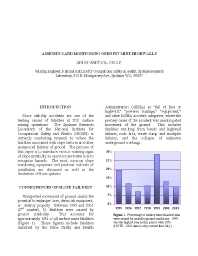Mining Publication: Assessing and Monitoring Open Pit Mine Highwalls
Original creation date: August 2001
Slope stability accidents are one of the leading causes of fatalities at U.S. surface mining operations. The Spokane Research Laboratory of the National Institute for Occupational Safety and Health (NIOSH) is currently conducting research to reduce the fatalities associated with slope failures and other unexpected failures of ground. The purpose of this paper is to introduce various warning signs of slope instability so operators are better able to recognize hazards. The most common slope monitoring equipment and practical methods of installation are discussed as well as the limitations of these systems.
Authors: JM Girard
Conference Paper - August 2001
NIOSHTIC2 Number: 20030390
Proceedings of the 32nd Annual Institute on Mining Health, Safety and Research, Salt Lake City, Utah, August 5-7, 2001. Jenkins FM, Langton J, McCarter MK, Rowe B, eds. Salt Lake City, UT: University of Utah, 2001 Aug; :159-171
See Also
- Advances in Remote Sensing Techniques for Monitoring Rock Falls and Slope Failures
- Analysis of Bench Crest Performance at the Yellowstone Mine: A Case Study
- Analysis of Safety Aspects and Mining Practices for Effective Ground Control in Surface Mining
- Applications of Ground-Based Radar to Mine Slope Monitoring
- Applications of Ground-Based Radar to Mine Slope Monitoring
- Applications of the Point Estimation Method for Stochastic Rock Slope Engineering
- Current Research on Slope Movement in Mines: Use of Hyperspectral Imagery
- Slope Stability
- Technology News 506 - The Sky is Falling!: NIOSH Releases Safety Video for Surface Mining Operations
- A User's Guide for the Bplane, Bstepp, and Bwedge Computer Programs
- Page last reviewed: 8/1/2017
- Page last updated: 9/21/2012
- Content source: National Institute for Occupational Safety and Health, Mining Program


 ShareCompartir
ShareCompartir
